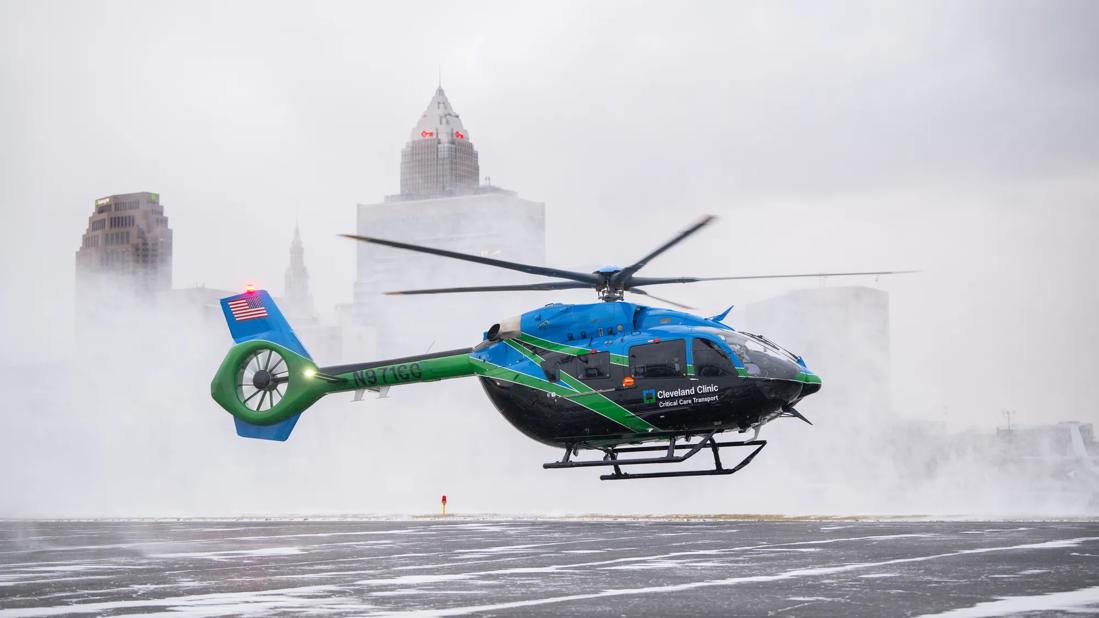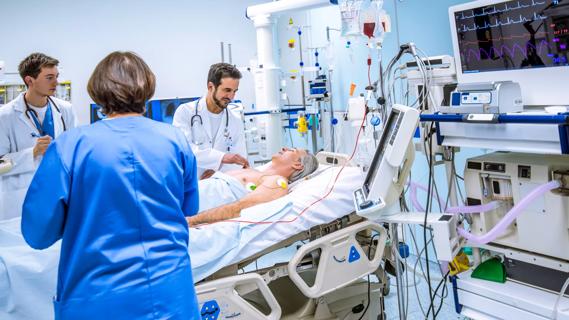Transport nurses prepare to manage all patients and acuity levels

When Jessica Knee, BSN, RN, CFRN, CCRN, NRP, joined Cleveland Clinic’s Critical Care Transport (CCT) team five years ago, she never imagined the depth at which she would expand her medical knowledge, or the clinical variety she would experience.
Advertisement
Cleveland Clinic is a non-profit academic medical center. Advertising on our site helps support our mission. We do not endorse non-Cleveland Clinic products or services. Policy
“We see every possible type of patient and all levels of illness,” she says. “From tenuous intensive care patients, time-sensitive emergencies and traumas to high-risk obstetrics (OB), patients on multiple cardiac devices and some stable intensive care unit (ICU) patients. The list is honestly endless.”
Knee is a registered nurse on the 80-member CCT team, which is comprised of nurses, nurse practitioners, clinical coordinators, paramedics, emergency medical technicians (EMTs), physicians and medical directors. The team provides 24/7 transport of critically ill and injured patients of all ages via ground mobile ICUs, helicopter or airplane. In 2024, they transported 7,700 patients — a record volume year.
“We are growing each year,” says Wanda Keaton, MHA, BSN, RN, CCRN, CFRN, the team’s nurse manager. “Growth is, in part, due to our amazing reputation and requests for the high-quality care we provide. It’s also driven by Cleveland Clinic’s continued expansion and service of more patients in more areas.”
Cleveland Clinic recently upgraded its rotor-wing aircraft fleet, replacing its previous critical transport helicopters with three new ones that are equipped with advanced safety features and other capabilities. It added another pediatric vehicle to its Akron service region to align with the expansion of Akron General’s neonate services, and a vehicle addition to the system’s southern Ohio region is forthcoming.
Two fixed-wing aircraft (planes), which participate in international transports, and five mobile ICUs — another dedicated to pediatric/neonate patients, one reserved as a mobile stroke unit, and three for adult patients — round out the fleet.
Advertisement
Although stationed in northeast Ohio, the CCT team has traveled to nearly every state and 28 countries.
“I’ve been to several states on fixed-wing transports,” Knee shares. “Several of my colleagues have gone international. We fly all over Ohio and into West Virginia, Pennsylvania, New York and Indiana. Ground transports are often closer.”
Ground teams are staffed with a critical care nurse, critical care paramedic and EMT, or two nurses and an EMT. An acute care nurse practitioner or a physician is on every flight, along with a critical care nurse or critical care paramedic and two pilots.
“Our rotor wing and fixed wings are different than other transport programs in that we always have a provider on board,” says Keaton.
Transport logistics is a huge part of the job admits Knee. “Clinical care of the patient is only one piece. Pre-planning goes into every call, and we often do it quickly,” she says.
With every transport, many considerations are taken. Some of those include:
•Pick-up and drop-off locations
•A divert location should the patient decompensate or code
•Needed oxygen/portable oxygen tanks
•Number of patient drips/drip back-up plan
•Specific placement of patient pumps, monitor and vent
•Plans for loading/unloading
•Intubation plan if needed
“There is no typical day,” Knee shares. “From the patient type to the sending/receiving hospital and the environment — no shifts or calls are ever the same.”
Keaton and Knee agree that the daily change is something that many CCT caregivers consider a job perk.
Advertisement
Each 12-hour shift starts with a report from the off-going crew. Pertinent information, such as vehicle assignments and supply needs, is reviewed. Teams proceed with medication, equipment and vehicle checks and wait for a call to come in. “It usually doesn’t take long,” says Knee.
Keaton agrees, “It’s very rare to not get an assignment.” In the event a call doesn’t come in, there’s still plenty of work to do. “There’s no such thing as a ‘nothing’ day,” she adds.
Continuing education and professional development are ongoing for CCT nurses at Cleveland Clinic. “We are always working on education, practice improvement, enhancement projects or research,” Keaton says. “We have committees for education, public relations outreach, research, quality, utilization review, safety and more.”
CCT nurses are currently analyzing data and assessing outcomes between intubated patients and those placed on an Airvo™ high flow device. Another in-process project is evaluating efficiency improvements to the team’s documentation process.
Training is crucial in the critical care transport world. Cleveland Clinic’s CCT caregivers attend quarterly education sessions on safety and quality. Utilizing the Case Western Reserve University Health Education Campus at Cleveland Clinic, they complete monthly simulated training and clinical scenario work. They also schedule various trauma training days throughout the year with emergency medical services and fire departments across the region.
“We practice a lot because we need to maintain proficiency in all our skills for any situation we encounter,” Knee says.
Advertisement
As part of their outreach efforts, CCT caregivers provide airway and left ventricular assist device (LVAD) training within the communities they serve.
Prior to joining the CCT team, Cleveland Clinic recommends that nurses have at least three years of experience or 4,000 hours working in critical care, including ventilator management, invasive hemodynamic monitoring and transvenous pacing.
Nurses are either certified transport registered nurses (CTRN) or certified flight registered nurses (CFRN). Those who serve the pediatric/neonate population also hold neonatal pediatric transport (C-NPT) certification. Other required certifications include basic life support (BLS), advanced cardiovascular life support (ACLS), pediatric advanced life support (PALS) and neonatal resuscitation program (NRP) certification. Nurses also complete either a trauma nurse core course (TNCC) or international trauma life support (ITLS) certification.
Recalling a transport where a patient seized and required immediate intubation just five minutes from the receiving hospital, Knee reflects on what it takes to be a good CCT nurse. “Remaining calm in stressful or new situations, the value of teamwork, clear and open communication, the ability to quickly and carefully adapt and overcome — these are all key,” she says.
Keaton agrees, “The coordination and quality of care our team provides to patients is truly amazing.”
Advertisement
Advertisement

Investigators are developing a deep learning model to predict health outcomes in ICUs.

Compassion, communication and critical thinking are key

How hospitals can weave ethics into daily nursing practice to strengthen patient-centered care

Guiding nurses amid a constantly evolving healthcare landscape

Ideation session generates solutions to medication administration errors

Caregivers spearhead changes that improve patient care, shape hospital culture

Building a culture that supports, engages and empowers nursing staff

Nurses harness cutting-edge technology as a bridge to healing